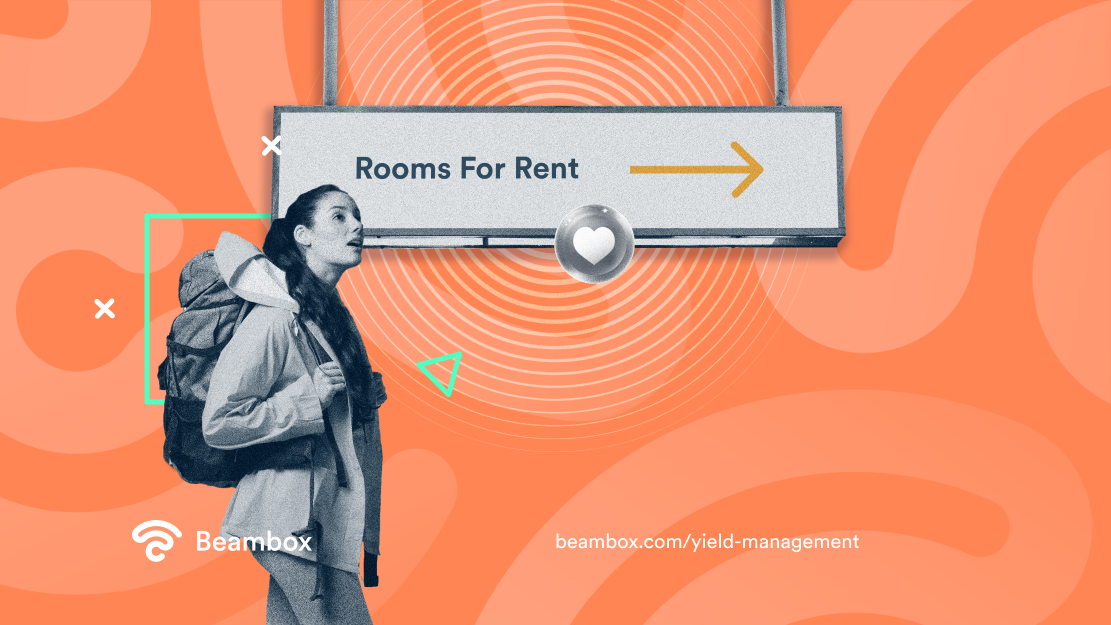Occupancy rates, maximum revenue per available room (RevPAR), supply and demand — these are key considerations for optimizing room pricing in hotels. To ensure that a hotel provides guests with the right room, at the right price, and at the right time while maximizing revenue and profit, hotels practice yield management — a variable pricing strategy that determines the right balance between room revenue and occupancy. Here’s your comprehensive guide to the yield management system in the hospitality industry.

Yield Management Meaning
Yield management is a variable hotel pricing strategy that generates the maximum revenue (yield) from a set number of rooms by finding the optimal balance between room rate and occupancy rate. The strategy is designed to understand and influence booking behaviors, and to determine the right price to offer a guest based on these behaviors. Yield management takes into consideration the following key factors:
- The fixed number of rooms in a hotel.
- A hotel’s inventory of rooms has an “expiration date,” i.e., the opportunity to sell a room on any given day is time-limited.
- Various conditions influence how much people are willing to pay for a room.
The concept of yield management was developed by the U.S. airline industry in the late 1970s. The post-deregulation era gave airlines greater control over airfares, which led to intense competition. The yield management system took shape in response to this competition, and was first conceptualized by Robert Crandall, former American Airlines CEO. Crandall “set out to
devise a system that would vary the proportion of discount and full-fare seats on a day by day, departure by departure basis.”
In its earliest iteration, yield management (a term also coined by Crandall) was used by American Airlines employees to monitor actual booking rates in various fare categories,
compare them against the predicted rate, and then adjust the inventory of variously priced seats accordingly. These adjustments included discounted fare offers for low-demand flights, increased fares for high-demand flights, higher costs for premium seats, ticket cancellation fees, and purchase restrictions, among others.
As the strategy proved highly effective, other industries also adopted it, including the hospitality industry.

How Is Revenue Management Different?
Yield management has a narrower focus than revenue management. Yield management is mostly concerned with maximizing revenue by controlling room prices and sales volume; revenue management, on the other hand, has broader considerations that goes beyond maximizing revenue yield from occupancy; these considerations include revenue from food and beverage outlets and other amenities, demand forecasts, and market segmentation based on predicted consumer behaviors.
Yield management is a strategy that’s smaller in scope and, therefore, an ideal starting point for a lodging owner/manager who’s new to the business.
Benefits of Yield Management
Maximum, if not full, occupancy is the goal of lodging establishments. Adding their business to Google Maps, effective reputation management, and aggressive marketing are just some of the best practices that contribute to a decent occupancy rate. Hotels can still ensure maximum revenue at varying occupancy rates, however, through effective yield management. Here’s how yield management’s dynamic pricing strategy helps hotels stay in business.
- It helps the establishment make the most money possible from their inventory of rooms through strategic pricing control. Optimal pricing is determined based on market conditions and customer behaviors, among other considerations.
- It helps yield the highest revenue from existing demand vis-a-vis related expenses. As hotels have fixed daily operating costs, changes in demand directly impact profitability. Yield management effectively maximizes revenue whether the demand is high or low.
- Automated yield management requires minimal human intervention and enables automatic application of optimal pricing in real-time based on available data.
Yield Management Pricing
Yield management pricing can be determined by using this basic formula:
Yield Management = (Achieved Revenue / Maximum Potential Revenue) * 100
Where:
Maximum Potential Revenue = Number of available rooms * price per room
Achieved Revenue = Number of rooms sold * price per room on a given night
For example, if your hotel has 50 rooms priced at $350 per room, your maximum potential revenue would be $17,500. If you sell 30 rooms at $300 each on a particular night, your achieved revenue would be $9,000. Your yield percentage for that night would be 51.4%.
Take note that there are a number of important factors to consider when determining the best price per room. During peak season, for example, high demand means you can increase your room rates. Even if you don’t sell all your rooms in any given night, you will still have a higher yield percentage and increased savings from having fewer rooms that need to be serviced. Booking volumes and room rates of other hotels in your area should also be considered.

How Do Resource Managers Achieve Maximum Sustainable Yield?
Achieving maximum sustainable yield requires an appropriate manipulation of pricing based on key factors, such as:
- Market trends, i.e., increasing prices when demand is high and lowering prices or offering promotions when demand is low.
- Occupancy rate vs room rate, i.e., if you reach maximum occupancy with a high room rate, you can maintain this rate until occupancy rate declines.
- Historical performance data, i.e., how your hotel did during the same period in previous years.
- Time of year and seasonality.
- Guest profiles and booking behaviors, i.e., if your hotel frequently caters to international guests, you can expect them to book longer stays and spend money on extra services.
- Hotel location.
The actual process of yield management can be done manually or by using an automated system. Manual yield management typically involves the following:
- Pulling rates and availability data from the hotel’s PMS.
- Pulling competitor data.
- Using a spreadsheet to combine all data sets and set up custom formulas to calculate key ratios.
- Analyzing the data to identify high/low trends and other areas of concern.
- Manually adjusting rates in the spreadsheet and uploading it to the system for distribution.
As yield management must be done regularly, the manual approach can be time-intensive and overwhelming. A manager has to constantly collect and analyze data to promptly respond to demand fluctuations and adjust rates accordingly. The automated approach, with the help of yield management software, is the ideal solution.
Yield Management Solutions
The ideal yield management solution is to automate processes with the use of software. Yield management software automatically pulls in and analyzes relevant data from a set of sources; identifies patterns at the property and market levels; predicts future demand; and generates rate recommendations. Recommended rates can be applied automatically and in real-time to ensure 24/7 optimal pricing.
Sophisticated technologies for yield management (and revenue management) are becoming more accessible to all types of hotels — big and small — everywhere in the world. Yield management software is readily available online and its widespread use means pricing has also become more competitive. Hotels that utilize automated solutions, especially those that have machine-learning capabilities, have the advantage of speedy, accurate, continuous, and up-to-date functions and optimized data-driven pricing.
Some yield management software allows customization of rates, rules, and alerts based on occupancy, market conditions, competitor activity, and other factors. You can determine optimal pricing and make real-time adjustments based on current and forecasted conditions to attract more guests on a daily basis and during peak and off-peak seasons.

Yield Management Examples
Here are some yield management examples which demonstrate how the strategy is leveraged across various industries.
- On a particular week, a roundtrip ticket on a given flight is quoted at $280; the same flight is quoted at $360 a week later, and then at $840 one week before the actual flight.
- “Early bird specials” and “Happy Hour” are often offered by restaurants to boost revenue during off-peak hours.
- When using a ridesharing service, the same route will have different rates when booked at different times of the day. “Surge pricing” is typically implemented during hours of high demand to maximize revenue and increase service to the area.
- Theater tickets are offered at different prices depending on the days of the week, show schedules (matinees, for example, are offered at lower prices), seating preferences, and when a ticket is purchased (advanced purchases vs same-day tickets).
- Hotels at a popular summer destination increase their room rates during the summer months, and offer discounted rates and other special promos during off-peak season.
Combining Yield Management and WiFi Marketing To Maximize Revenue
Yield management tools heavily rely on customer behaviors, among other relevant data, to determine the right price and the right room to offer each customer at the right time. From building an email list to connecting with your guests on social media and identifying key demographic information, the right WiFi system for your hotel can serve as a key data resource that provides valuable insights about your guests.
A fully customizable WiFi marketing platform, such as Beambox, will allow you to enhance guest WiFi experience, manage WiFi access, and utilize various other functions to help you better serve your guests’ needs and achieve optimal yield for your hotel.
Beambox offers a number of ways to make your WiFi network work to your advantage while delivering connectivity service to your guests. You can limit WiFi access per room, within designated parameters around the hotel, and based on download speeds and sizes; you can display targeted content or drive more followers to your social media via a customized captive portal login; you can harness valuable guest data and have a better understanding of the people who book with your hotel through smart marketing tools; and you can automatically prompt customers to leave a review.
Beambox is an all-in-one WiFi solution that accomplishes all of the above and more. We have an existing client base of over 3,000 venues, and our customizable WiFi marketing solutions have been used in impressive and rewarding ways. You can drive sales with time-sensitive deals and promos for your restaurant, boost social engagement through Instagram or Facebook contests, and climb up on online ranking platforms through real-time customer reviews. Accelerate your business growth — start your Beambox free trial today!
Get Started With Free WiFi Marketing
Beambox helps businesses like yours grow with data capture, marketing automation and reputation management.
Sign up for 30 days free